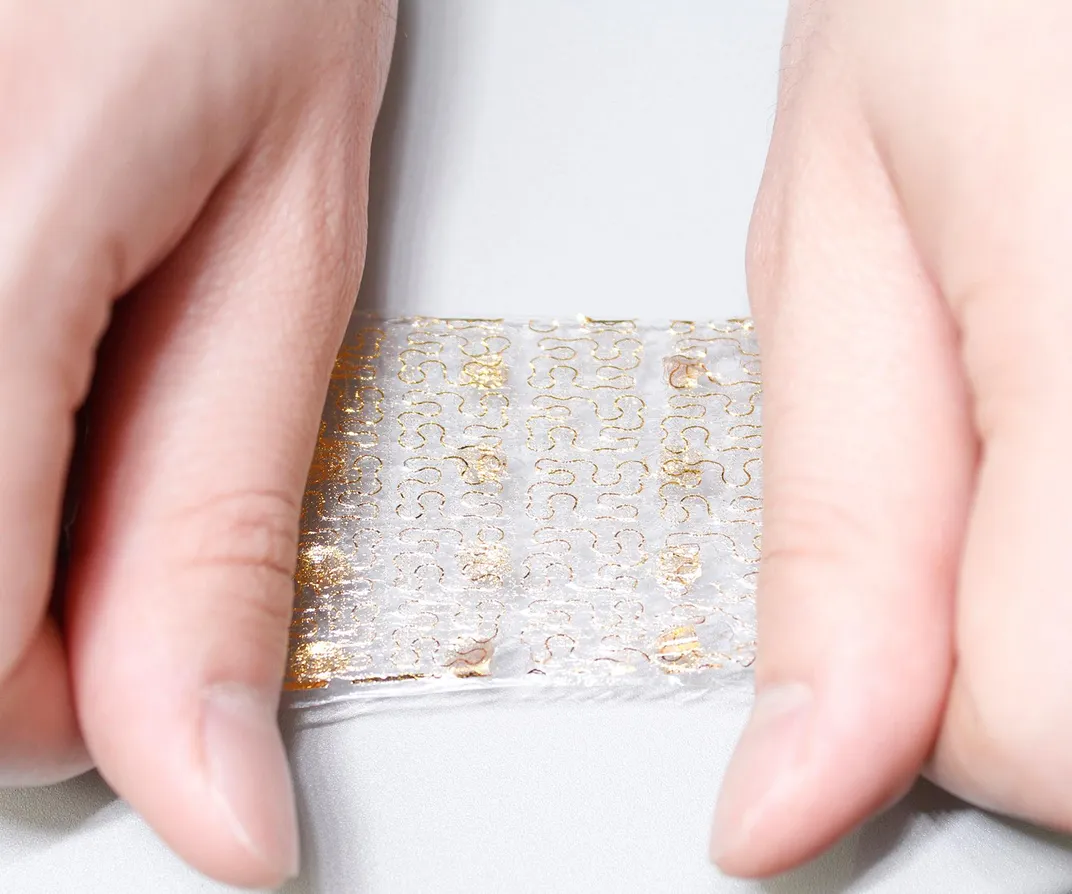Artificial Skin Could Help Prosthesis Wearers Feel, For Real
A new polymer with a lattice of embedded sensors is sensitive to heat, humidity and pressure
:focal(1637x757:1638x758)/https://tf-cmsv2-smithsonianmag-media.s3.amazonaws.com/filer/33/c8/33c8d004-7a2a-467e-b021-767a5d5c6d8e/smart-skin-hand-141209.jpg)
In the last year, doctors and engineers have seen great success in providing amputees with highly controllable prosthetic limbs. The DEKA "Luke Arm," for instance, gives the wearer precise enough control to eat with chopsticks—it’s also the first bionic arm approved by the FDA.
But communication with these artificial limbs is something of a one-way street. Users can control the arms, hands and feet through carefully designed connections with existing nerves and muscles, but they don’t get ready feedback from the artificial limb the way they would through real skin. That means they might not know when something is piping hot, extremely delicate or about to slip out of their grasp.
Earlier this week, researchers from Seoul National University and the Cambridge, Massachusetts-based wearables startup MC10 unveiled their solution: a sensor-laden polymer designed to stretch and feel like real, human skin that could cover prosthetic devices and give wearers a sense of touch in the future. The team, led by Dae-Hyeong Kim, published its research in the journal Nature Communications.
The key innovation here is flexibility—both in terms of physical dexterity and range of sensations. Unlike sensors used in prior efforts, Kim’s are able to move and stretch like skin. Thin strips of gold and silicone embedded in a polymer, called elastomer, amount to up to 400 sensors per square millimeter. The strips are woven into a lattice, which allows the material to stretch with minimal risk of fracture. A network of stretchable electrodes simulates nerves. Together, the sensors can detect temperature, humidity, pressure and physical strain.
Not every part of the material stretches equally, however, since researchers wanted to match its flex with variations inherent throughout the body. "Some parts of the hand stretch only several percent, while other parts [stretch] more than 20 percent," Kim explained to LiveScience. At the same time, different areas of the body have more or less flex; for instance, the skin over a knee is more flexible than that on a hand. Small heaters within the polymer give it the warmth of human skin.

While the project is encouraging, experts say it’s far from actionable just yet. “This proof-of-concept demonstration is interesting, but there is a lot of hard work that remains to show the robustness and performance necessary to translate this device to usable prosthetic hands,” Dustin Tyler, a professor of biomedical engineering at Case Western Reserve University who specializes in neural interfaces, told MIT Technology Review.
Specifically, the team must figure out a way to connect the skin to a human’s central nervous system, allowing him or her to experience the sensations it provides. The prototype interacts with a rat’s nervous system through a series of platinum nanowires treated to prevent inflammation. So far, the researchers have successfully demonstrated that the skin can trigger a rat’s sensory cortex, but can’t tell what senses are being triggered. They’ll need to move onto testing in larger animals next, before venturing to human trials.
Kim’s work has a conceptual leg-up on prior efforts, which generally convey one sense at a time. For instance, last year, Tyler and colleagues at the Cleveland Veterans Affairs Medical Center were able to convey the sense of touch through 20 sensors in a prosthetic hand by connecting the device to nerve bundles. And early this year, researchers at the Swiss Federal Institute of Technology used a similar method to allow an amputee to distinguish the shape of objects through touch. Meanwhile, a team at Northwestern University has successfully conveyed feelings of temperature and vibration by using existing muscles as sensory amplifiers.
Kim and his team patented their design, but they have no timeline, at this point, for releasing the artificial skin to the public.
/https://tf-cmsv2-smithsonianmag-media.s3.amazonaws.com/accounts/headshot/me.jpg)
/https://tf-cmsv2-smithsonianmag-media.s3.amazonaws.com/accounts/headshot/me.jpg)